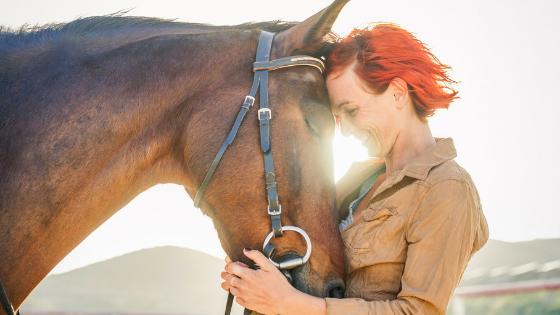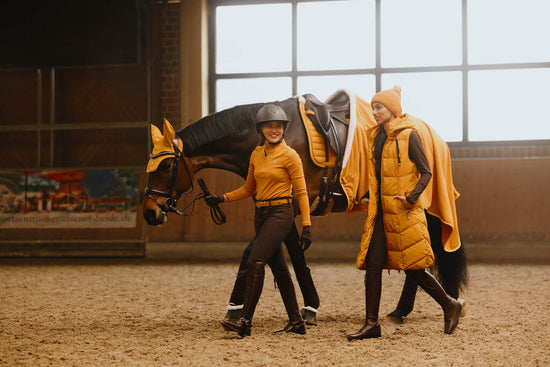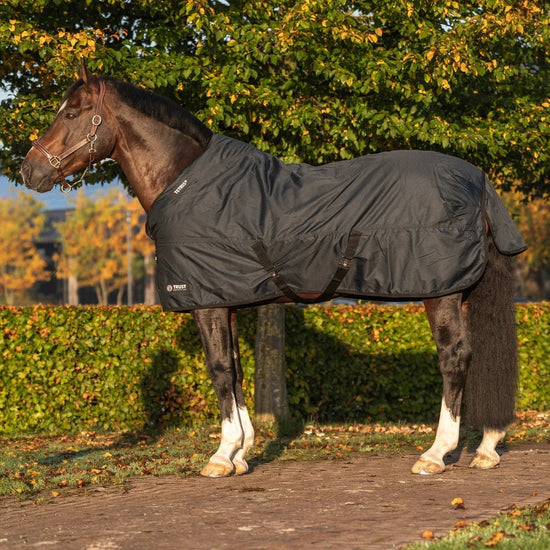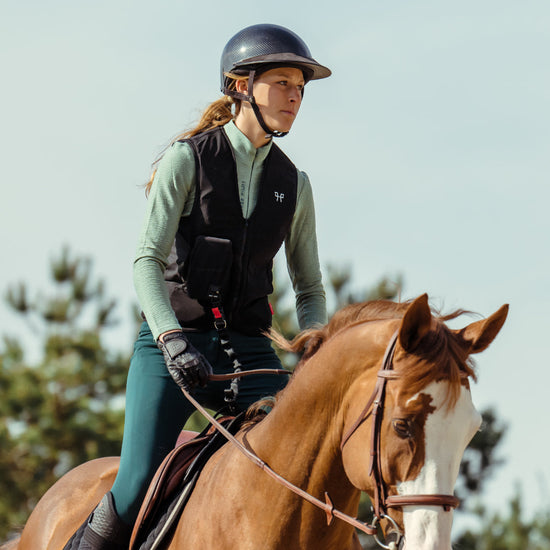When I bought my first horse all by myself, I was so excited and eager to get my horse that I didn't even think about many aspects. Even now, the tingling feeling of 'Did I do everything? Did I get everything right?' comes up writing these lines. However, the EquiZone Team and I want to make sure you are on the right track and have your checklist ready when buying your first horse. And we have some suggestions for what you actually need for it from the start!
Tips and Tricks for new horse owners
What you should consider and what you need as first equipment
PAPERWORK
The Contract
It is of course important that you conclude a legally correct sales contract with the old owner of your new horse. In addition to the amount of the purchase price, this also regulates the possibility of returning the horse in the event of damage to health that was concealed during the purchase. When I bought my first horse, I did not pay close attention to the details in the sales contract, and I fully trusted the former owner - and I am still grateful to her for keeping our verbal agreements!
Many times I have seen and heard of cases were someone tried their dream horse and had a complete changed horse after a few days at the new stables, as some aspects were hidden by the former owner or verbal agreement did not mean anything. So make sure you write everything down, even the smallest thing like 'Difficult to load' or 'Does not stand still at the farriers'.
Insurance
One of the most important aspects that is forgotten many times. Make sure you have a good and adequate liability insurance for your horse. These cover damage to poperty and personal injuries that are caused by the horse. That can start from damage to fences or the rented stable and covers injuries caused by a riding accident or when handling your horse. Make sure to be well informed and always compare different providers. Here are some more aspects to look at:
- The amount of the deductible in the event of property damage and accidents
- Co-insurance of foreign riders (fixed participation and friends)
- Insurance of bitless and saddle-free riding
- Co-insurance of short and long stays abroad
- Minimum contract term & special right of termination (12 months are usual, leaving when the horse dies should not cause issues)
Tip: Talk to your health insurance in how far they cover injuries related to accidents with horses and how they connect with your liability insurance!
The Passport
When you are buying a horse, it should have a passport with all relevant information, such as identification, pedigree and vaccinations. The breeder has to register a horse at a breeding association and is filled in as the first owner of the horse. So if you buy a horse, that is for example registered at the Holstein Studbook, you should send the passport and a copy of the sales contract to the regarding departement at the Holsteiner Verband and get yourself signed in as the owner. They will charge a small processing fee, but it will give you more security when someone should question the ownership. Furthermore, most horses come with an Ownership-certificate that should also be handed over together with the passport when you pick up your horse.
Tip: Always remember to have the passport with you when transporting your horse! The passport always have to be with the horse in case authorities doing controls.
THE FIRST FEW DAYS
I know it will be really difficult to not do everything right away. I know you want to go on hacks, ride in the new arena, jump a course, take care of your horse every second of the day and so on. I was exaclty the same!
But remember: the horse is a creature of habit and doesn't necessarily like changes. If your new horse doesn't have to change stables and you stay in the same stable together, or if you've even ridden it a lot before, of course not that much changes. But if you change stables like me, that is a lot of new and unknown things for your horse, which also means stress for your horse.
Therefore, you should take it easy for the first few days and let your horse arrive first. Don't ride like crazy and don't bring all your friends with you to show them your wonderful new horse - even if you are probably, just like me, proud as hell. Give your horse time to get used to the new situation and the new stable. Because remember, everything is really alien to your horse: the environment, the smells, the feed, the other horses. Maybe it's even sad because it misses its old pasture buddies. Do not forget that!
Careful:
If your horse will go out with other horses, it will also be placed in a new herd. Faults can quickly lead to injuries that are completely normal and that you should be prepared for. It is best to always have blue spray, zinc ointment, betaisadona and elastic gauze bandages, a set of wound pads and adhesive tape ready - more on that in a moment. In addition, wounds can become infected more quickly as your horse is more susceptible to the stress of moving.
FIRST EQUIPMENT - WHAT DO I NEED?
For my first horse I was quite lucky that I was allowed to take over lots of stuff from the former owner and I owned a few things already from former ponies I rode as a co-rider. However, with the flood of products you can buy it can be difficult to see what is really needed in the beginning.
The most important: A well-fitted saddle
The main piece for your horse will be the saddle. Most of the times horses are sold with their saddle, but in case you do not get the saddle or you want a different one, as it doesn't match your needs, it is important to find one that fits your horse and you! Make sure to check the current saddle by an educated saddle fitter and get the money for needed changes.
Tip: Invest in good fitted saddle
Sometimes small adjustments such as padding are enough, but sometimes a completely new saddle is needed. Don't buy the next best or even a cheap mass saddle here, but invest good money in a suitable saddle - even if it can cost up to several thousand euros! Be aware of the use of the saddle and your riding style:
Different saddle types:
- General purpose saddles
- Dressage saddles
- Jumping saddles
- Western saddles
- Trail riding saddles
- Treeless saddles
Important: You will save your horse and yourself a lot of trouble in the long run if you get an absolutely suitable saddle for your horse right from the start and take good care of it - a blog post on how to take care of your tack will follow soon. Keep your eyes open!
There is an awful lot of horse accessories out there, and you can buy everything in multiple versions. In my opinion, quality is much more important than quantity. Here are the most important horse accessories that are part of the initial equipment:
LIST OF HORSE ACCESSORIES FOR THE INITIAL EQUIPMENT:
- 1x halter and leadrope
- 1x bridle with reins (also without a safety strap or bitless)
- 2x saddle pads
- 1x sweat blanket
- 1x boots or bandages
- 1x rainproof outdoor / winter blanket
List of cleaning and other accessories:
- 1x grooming box
- 1x hoof pick with brush
- 1x Body brush
- 1x mane comb
- 1x grooming brush (for head and legs)
- 1x hard toothed curry comb (for dried mud in the fur)
- 1x scrapers
- 1x sponge
- 1x (old) towel
A guide on how to take care of your horse will also be published on this blog soon!
Equipment for the emergency box:
- 1x disinfecting spray (can burn a lot, so use carefully)
- 1x zinc ointment and/or Betaisodona ointment (allows wounds to heal quickly)
- elastic gauze bandages
- Set of wound pads and wound wool
- Duct tape
- 1x scissors
ADDITIONALLY GOOD TO HAVE
Most of the things you can also lend from fellow stable friends, however it is good to have them yourself. I was always afraid to break something from others and it is much more hygienic to use your own as your equipment only comes into contact with one horse and it reduces the risk of skin issues.
So you should consider getting a lunging line, a lunging whip and a lunging roller.
And of course: You need some comfy riding clothes as well! Check out our rider collection here.
CONCLUSION
Owning your first horse is a big deal and most of the time, feelings go crazy in the first few days after the purchase (and of course before)! When I bought my first own horse, I approached the purchase rather haphazardly and just let my heart take the decisions. Today I know how important a detailed sales contract and written agreements are, what is part of a good horse liability insurance, and that it is good to have an equine passport including registration as the owner.
So that your horse is doing well after a stable move, you should first let it arrive in peace. Be prepared for possible injuries that may result from little fights within the new herd. The core of good initial equipment is above all a properly fitting saddle for your horse. Even if a good saddle can be expensive, you should definitely not save money! In addition to other horse accessories, an emergency box for wound care is also an advantage and a must have.
And most important: Enjoy the time with your new four legged family member!





